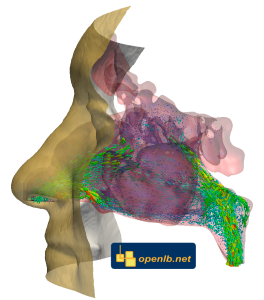The human nose consists of an outer, visible and an inner part. The outer part is based in the center of the face and formed by the nasal bone (Os nasale), the ala of the nose and some small pieces of cartilage.

The inner part of the nose consists of the nasal vestibule (Vestibulum nasi), which is reached through the nostrils (Nares), the nasal cavity (Cavitas nasi) and the paranasal sinuses (Sinus paranasales). The nasal cavity is divided by the nasal septum (Septum nasi) in two independent parts. Each part itself is divided in three nasal meatus (Meatus nasi), the superior, the middle and the inferior meatus. The nasal cavity is communicating with the paranasal sinuses through vents in the superior and the middle meatus. Parts of the paranasal sinuses are the maxillary sinus (Sinus maxillaris), which is the largest sinus based behind the orbits, the frontal sinus (Sinus frontalis) based behind the superciliary arches, the ethmoid sinus (Sinus ethmoidales), which consists of about 10 smaller caves and is based between the upper parts of the nasal cavity and the orbits, and the sphenoidal sinus (Sinus sphenoidalis).
The inner surface (about 140-160cm²) of the nasal cavity and the paranasal sinuses are covered in nasal mucosa, which is exchanged every 10 hours.
The functions of the nose are cooling or warming the air up to 1 degree of the human body temperature and humidifying and cleaning the air from dust and other particles. Additionally about 20-30 million receptor cells for the sense of the smell are situated in the superior meatus.
Simulations of the airflow in the human nose has been perfomed using OpenLB.
More information:
Contributed by Thomas Henn, Mathias J. Krause, Simon Zimny.
